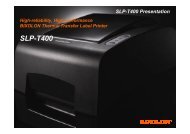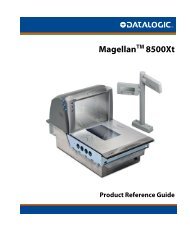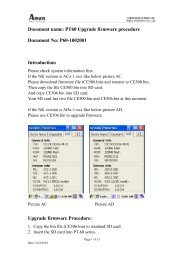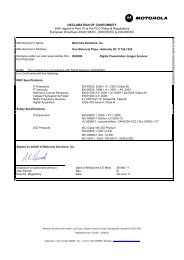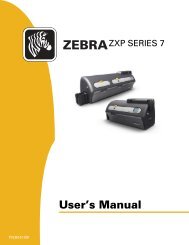You also want an ePaper? Increase the reach of your titles
YUMPU automatically turns print PDFs into web optimized ePapers that Google loves.
Zebra Desktop Series<br />
<strong>LP</strong>/T<strong>LP</strong> <strong>2844</strong> Product Guide<br />
Competitive Information<br />
The following pages were compiled from the latest manufacturer’s product information as of the<br />
date of this document. In cases where conflicting product specification or functionality information<br />
was discovered between a given manufacturer’s printed or on-line material, the manufacturer was<br />
contacted directly for clarification.<br />
Products were acquired for purposes of hands-on competitive analysis performed by engineering<br />
and product management teams.<br />
Performance testing was performed as follows:<br />
Test Station<br />
All products were tested from the same PC.<br />
• Dell Latitude CPi 400Mhz Pentium II, 128Mb RAM, with 8Gb of available hard-disk capacity<br />
(i.e., no swap-space limitation), and equipped with Microsoft Windows 98, Second Edition<br />
operating system, set to Windows VM control.<br />
• All serial interface test-runs were performed using the same high-quality shielded RS-232<br />
serial cable.<br />
• All parallel interface test-runs were performed using the same high-quality fully-shielded IEEE<br />
1284 parallel cable.<br />
Test Labels:<br />
All labels were created by hand-coding two real-world label formats with barcodes using the<br />
manufacturer’s specific label programming language. These were produced as identically as<br />
possible across manufacturers. This procedure isolated the performance characteristics of each<br />
tested unit to that of the device’s controller electronics and motion dynamics; i.e., no driver<br />
overhead or variability.<br />
• AIAG compliance label<br />
• K-Mart compliance label<br />
• For multi-label test runs, 50 unique sets of numeric data was modified in the label program,<br />
terminated with a memory-flush statement in each, and concatenated into one file.<br />
Methodology:<br />
• The PC was booted in DOS mode for each test-run.<br />
• Label programs were downloaded from the DOS prompt using proprietary parallel and serial<br />
file downloading utilities.<br />
• All parallel tests were performed in ECP mode as set in the PC’s BIOS.<br />
• All serial tests were performed @38.4kbs as set by the serial downloading utility.<br />
Timing:<br />
• Timing was performed commencing the test from actuation of the PC’s [ENTER] key to start<br />
the download, and concluding at the point in time when the trailing-edge of each label (in the<br />
case of first-label-out tests), or when the last of 50 labels (in the case of multi-label tests),<br />
ceased forward movement.<br />
• Three (3) test-runs were performed for each of the two label designs (x) both PC interfaces<br />
(x) both single and multi-label combinations, for a total of 24 independent tests for each<br />
product. (3 runs x 2 label types x 2 I/Fs x 2 label volumes.) An average time for each threerun<br />
test was then calculated for every combination, resulting in eight (8) summary charts. A<br />
calibrated Fisher Scientific NIST-traceable timing device was used to monitor each even.<br />
Zebra <strong>LP</strong>/T<strong>LP</strong> <strong>2844</strong> Product Guide<br />
RevZ1 April 2001<br />
16



